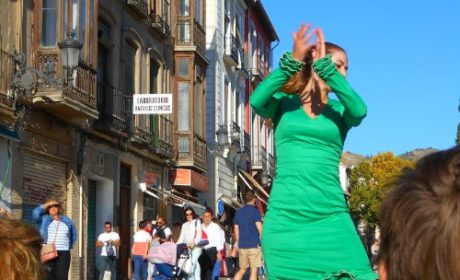Are you looking for a quick getaway from Madrid, Spain? Nicole Jewell says Toro will fit your requirements nicely. Keep reading for Nicole’s tips for a weekend of wine and wandering in Toro, Spain based upon a weekend road trip that she took with her husband.
I admit that I was drawn to visit Toro, Spain, recently thanks to its mostly local reputation for producing great wines. Although not quite as well-known internationally as the ubiquitous Rioja, the Toro region has been producing wine for centuries and they’re delicious in their own right.
Table of Contents
How to visit Toro, Spain
Of course, apart from indulging in some very nice vino tinto, one of the best things about exploring Spain is visiting the historical landmarks that even the smallest of pueblos seem to have. Anywhere you go in the Iberian peninsula—and certainly in the Castile and Leon region—you’ll find traces of the country’s fascinating history.
Although my husband and I initially thought that Toro was going to be a small quiet pueblo with little to explore, we ended up in a vibrant town with oodles of interesting landmarks.
Driving to Toro from Madrid

Toro is about two and a half hours northwest of Madrid. The highway route passes straight through Spain’s expansive plains, scattered throughout with herds of grazing goats, sheep, and, of course, bulls.
It’s a fairly boring drive, but we did have a chance to stop in Medina del Campo. This off-the-beaten path pueblo is actually the final resting place of Queen Isabella, and a nice spot to stretch your legs or get a bite to eat. Afterwards, grab a coffee and stroll around the Castle of La Mota, which was built around 1080.
After leaving Medina del Campo, we arrived in Toro, which, like most of this region of Spain, is known for its Romanesque monuments. The Collegiate Church of Santa María la Mayor, which goes back to the mid-13th century, greeted us majestically wrapped in a dense fog.

Once we explored the Plaza Mayor and sufficiently tested out the wonderful tapa scene for lunch, we took a tour of the Sancti Spiritus Monastery, which was also built in the 14th century. The building used to house widows and other unmarried women, and at one time, there was over 600 women living in the small monastery.

Another great landmark must-see in Toro is the granite megalithic bull monuments that go back to the Iron Age. I believe there are over 400 Verraco sculptures in the Iberian Peninsula.
Of course, these monuments hold a special meaning for Toro. When Alfonso III took over the city during the “reconquista“, the bull was the first thing he saw, and accordingly named the town in its honor.
Boomer Travel Tip
Are you inspired to plan a Spanish adventure? Check out our Spain Travel Planner to get started!
Sipping on wine in Toro

Most serious oenophiles will be familiar with Toro’s wine producing sector, which is made possible due to its proximity to the beautiful Douro River. Toro wine has been around for centuries, and was famously the wine of choice for Columbus, who took barrels of it with him on his journey to discover America.
The wine’s strong structure and body was thought to make it the only wine that could survive the long journey. Now that’s a great piece of history!
If you like red wine, you’ll love Toro wines. (Not a big fan of white wine myself, but I’ll bet they’re delicious as well.) If you visit, make sure to check out the bodega tours offered by Gran Elías Mora, Estancia Piedra Platino, and well, just about any other Toro bodega (wine cellar) that strikes your fancy. Trust me—you really can’t go wrong!
Boomer Travel Tip
Have we inspired you to plan a Spanish adventure? Check out our Spain Destination Guide for some help!
A day trip to Zamora

Although I was content to bar hop and taste various local vintages along the way, a certain history-loving someone needed to quench his thirst for education. So, off we went to Zamora. Although much bigger than Toro, Zamora is often thought of as another quiet town.
Zamora’s claim to fame is its renowned Semana Santa processions that take place during Easter week. Unlike most of Spain’s religious processions that generally have fairly jovial, or at least lively, atmosphere, Zamora’s processions are dead silent and spookily solemn.
To get an idea of what the processions mean to the city, be sure to check out the city’s Semana Santa Museum. Take the audio tour as you pass by the different “pasos” or religious floats that are carried during the week on the backs of the various church brotherhoods.
Additionally, Zamora has a shocking amount of Romanesque churches, twelve in total. There seems to be one almost on every corner and it’s simply astonishing to see these beautiful structures sit smack dab in the city’s pedestrian areas, but it certainly makes it very convenient to visit them.

All in all, our quiet weekend visit to Toro turned out to be an eye-opening lesson in underestimating Spain’s lesser known areas. The Zamora/Toro region is an extremely exciting place to visit and once you’re done with all of the amazing architecture and history, sitting down to a nice tapa and tasty glass of local wine is just the icing on the Spanish cake!
More fun day trips from Madrid:
- Visit Girona for the great day trips.
- How to take a day trip to Toledo, Spain
- Tips for taking a day trip to Segovia
- Visit Caceres, the city of birds.
Save to Pinterest




